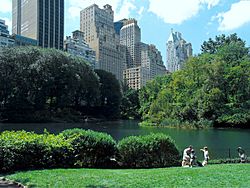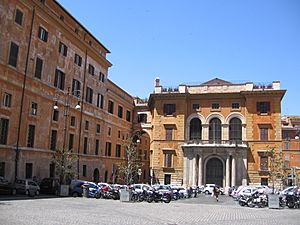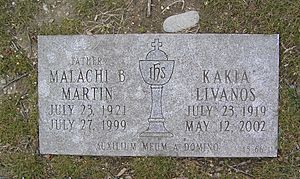Malachi Martin facts for kids
Quick facts for kids
Malachi Brendan Martin
|
|
|---|---|
| Born | 23 July 1921 Ballylongford, County Kerry, Ireland |
| Died | 27 July 1999 (aged 78) New York, New York, U.S. |
| Pen name | Michael Serafian |
| Occupation | Biblical archaeologist Catholic priest Exorcist Novelist Professor Theologian |
| Nationality | Irish, American |
| Relatives | F. X. Martin (brother) |
Malachi Brendan Martin (23 July 1921 – 27 July 1999), also known under the pseudonym of Michael Serafian, was an Irish-born American Traditionalist Catholic priest, biblical archaeologist, exorcist, palaeographer, professor, and prolific writer on the Roman Catholic Church.
Ordained as a Jesuit priest, Martin became Professor of Palaeography at the Pontifical Biblical Institute in Rome. From 1958, he served as secretary to Cardinal Augustin Bea during preparations for the Second Vatican Council. Disillusioned by Vatican II, Martin asked to be released from certain aspects of his Jesuit vows in 1964 and moved to New York City.
Martin's 17 novels and non-fiction books were frequently critical of the Catholic hierarchy, who he believed had failed to act on what he called "the Third Prophecy" revealed by the Virgin Mary at Fátima. ..... The Final Conclave (1978) was a warning against Soviet espionage in the Vatican.
Contents
History
Early life, education and ordination
Martin was born in Ballylongford, County Kerry, Ireland, to a middle-class family in which the children were raised speaking Irish at the dinner table. His parents, Conor and Katherine Fitzmaurice Martin, had five sons and five daughters. Four of the five sons became priests, including his younger brother, Francis Xavier Martin.
Martin attended Belvedere College in Dublin, then studied philosophy for three years at University College Dublin. On 6 September 1939, he became a novice with the Society of Jesus. Martin taught for three years, spending four years at Milltown Park, Dublin, and was ordained in August 1954.
Upon completion of his degree course in Dublin, Martin was sent to the Catholic University of Louvain in Belgium, where he took a doctorate in archaeology, Oriental history, and Semitic languages. He started postgraduate studies at both the Hebrew University of Jerusalem and at the University of Oxford. Martin specialized in intertestamentary studies, Jesus in Jewish and Islamic sources, Ancient Hebrew and Arabic manuscripts. He undertook additional study in rational psychology, experimental psychology, physics, and anthropology.
Work
Martin participated in the research on the Dead Sea Scrolls and published 24 articles on Semitic palaeography. He did archaeological research and worked extensively on the Byblos syllabary in Byblos, in Tyre, and in the Sinai Peninsula. Martin assisted in his first exorcism while working in Egypt for archaeological research. In 1958, he published a work in two volumes, The Scribal Character of the Dead Sea Scrolls.
In 1958, Martin was assigned to serve as a private secretary to Cardinal Augustin Bea, working with him in the Vatican until 1964. Martin's years in Rome coincided with the beginning of the Second Vatican Council (1962–65), which was to transform the Catholic Church in a way that the initially liberal Martin began to find distressing. He became friends with Monsignor George Gilmary Higgins and Father John Courtney Murray.
In Rome, Martin became a professor at the Pontifical Biblical Institute, where he taught Aramaic, Hebrew, palaeography, and Sacred Scripture. He also taught theology, part-time, at Loyola University Chicago's John Felice Rome Center. Martin worked as a translator for the Eastern Orthodox Churches and Ancient Oriental Churches Division of the Secretariat for Promoting Christian Unity under Bea. Martin became acquainted with Jewish leaders, such as Rabbi Abraham Joshua Heschel, in 1961 and 1962. Martin accompanied Pope Paul VI on a trip to Jordan in January 1964. He resigned his position at the Pontifical Institute in June 1964.
In 1964, Martin requested a release from his vows and from the Jesuit Order. He received a provisional release in May 1965 and a dispensation from his vows of poverty and obedience on 30 June 1965 (cf. qualified exclaustration). Even if dispensed from his religious vow of chastity, Martin remained under the obligation of chastity if still an ordained secular priest. Martin maintained that he remained a priest, saying that he had received a dispensation from Paul VI to that effect.
Martin moved to New York City in 1966, working as a dishwasher, a waiter, and taxi driver, while continuing to write. He co-founded an antiques firm and was active in communications and media for the rest of his life.
Communications and media

In 1967, Martin received his first Guggenheim Fellowship. In 1970, he published the book The Encounter: Religion in Crisis, winning the Choice Book Award of the American Library Association. He then published Three Popes and the Cardinal: The Church of Pius, John and Paul in its Encounter with Human History (1972) and Jesus Now (1973). In 1970, Martin became a naturalized U.S. citizen.
In 1969, Martin received a second Guggenheim Fellowship, allowing him to write his first of four bestsellers, Hostage to the Devil: The Possession and Exorcism of Five Living Americans (1976). In the book, Martin calls himself an exorcist, claiming he assisted in several exorcisms. According to McManus Darraugh, William Peter Blatty "wrote a tirade against Malachi, saying his 1976 book was a fantasy, and he was just trying to cash in." Darraugh also said that Martin became "an iconic person in the paranormal world."
Martin served as religious editor for the National Review from 1972 to 1978. He was interviewed twice by William F. Buckley, Jr. for Firing Line on PBS. He was an editor for the Encyclopædia Britannica.
Martin published several works of fiction and non-fiction in the following years:
- Hostage to the Devil: The Possession and Exorcism of Five Living Americans (1976)
- The Final Conclave (1978)
- King of Kings: a Novel of the Life of David (1980)
- Vatican: A Novel (1986)
His other works included:
- The Pilgrim (1964)
- The Encounter (1970)
- The Decline and Fall of the Roman Church (1981)
- The New Castle: Reaching for the Ultimate (1982)
- Rich Church, Poor Church: The Catholic Church and its Money (1984)
- There is Still Love: Five Parables of God's Love That Will Change Your Life (1984)
Martin's bestselling 1987 non-fiction book, The Jesuits: The Society of Jesus and the Betrayal of the Roman Catholic Church, was highly critical of the Jesuit Order, accusing the Jesuits of systematically undermining church teachings.
Later life
Martin was a periodic guest on Art Bell's radio program, Coast to Coast AM, between 1996 and 1998. The show continues to play tapes of his interviews on Halloween.
Martin's The Keys of This Blood: The Struggle for World Dominion between Pope John Paul II, Mikhail Gorbachev, and the Capitalist West was published in 1990. It was followed in 1996 by Windswept House: A Vatican Novel.
The Vatican restored Martin's faculty to celebrate Mass in 1989, at his request. He was strongly supported by some Traditionalist Catholic sources and severely criticized by other sources, such as the National Catholic Reporter. Martin served as a guest commentator for CNN during the live coverage of the visit of Pope John Paul II to the United States in October 1995.
In the last three years of his life, Martin forged a close friendship with the Traditionalist Catholic philosopher Rama P. Coomaraswamy (1929–2006). During this period, Martin was received in a private audience by John Paul II.
Death
In 1999, Malachi Martin died in Manhattan of an intracerebral hemorrhage, four days after his 78th birthday. It was caused by a fall in his apartment in Manhattan. The documentary Hostage to the Devil claimed that Martin said he was pushed from a stool by a demonic force.
Martin's funeral took place in St. Anthony of Padua Roman Catholic Chapel of West Orange, New Jersey, before the burial at Gate of Heaven Cemetery, in Hawthorne, New York.
Writings
In 1964, under the pseudonym of "Michael Serafian", Martin wrote The Pilgrim: Pope Paul VI, the Council, & the Church in a Time of Decision. The book contained Martin's views on the Jewish question in Europe and on the Second Vatican Council. Martin's fictional works purported to give detailed insider accounts of Church history during the reigns of Popes Pius XII, John XXIII, Paul VI (The Pilgrim, Three Popes and the Cardinal, Vatican: A Novel), John Paul I (The Final Conclave) and John Paul II (The Keys of This Blood, Windswept House).
.....
Opinions
Three secrets of Fátima
Martin often spoke and wrote about the Three Secrets of Fátima and was an ardent supporter of Father Nicholas Gruner's interpretations of them: "Father Gruner is fulfilling a desperately needed function in the ongoing perception of Mary's role in the salvation of our imperiled world. Father Gruner is absolutely correct that the consecration of Russia as Our Lady desired, has not been executed". According to Martin, the unreleased third secret of Fatima was that the Soviet Union would be converted to Christianity. The Vatican released what it claimed to be the third secret letter in 2000. This text did not mention Russia or the Soviet Union.
Other theories
Martin did not believe in the alleged apparitions of the Virgin Mary at Međugorje in what is today Bosnia and Herzegovina. He said that false pretenses were used in obtaining earlier his recommendation. Concerning the Garabandal apparitions, he remained open minded.
In March 1997, Martin claimed on Radio Liberty's Steel on Steel, that two popes were murdered during the 20th century:
- Pope Pius XI was allegedly murdered by Benito Mussolini, because of his 1931 encyclical, Non abbiamo bisogno, which was critical of the Italian Fascist state.
- Pope John Paul I was allegedly murdered according to Martin's book, Vatican: A Novel, by Jean-Marie Villot, formerly Cardinal Secretary of State under Pope Paul VI, under orders from the Soviet Union.
Martin stated that, along with diabolic possession, angelic possession also exists and that angels could have use of preternatural powers in certain circumstances.
Siri theory
Martin partially gave credence to the Siri thesis, saying that Cardinal Giuseppe Siri was twice elected pope in papal conclaves, but declined his election after being pressured by so-called worldly forces acting through cardinals present at the conclaves. Martin called this the little brutality. On the one hand, Martin says that Siri was intimidated; on the other hand he says that Siri did indicate that his decision not to accept was made freely.
- The first election, according to Martin, happened at Papal conclave, 1963. Martin mentioned the possibility of a nuclear threat which involved "the very existence of the Vatican state" during this conclave on pages 600–610 of The Keys of this Blood,
- The second election was the Papal conclave, October 1978. Martin said on Steel on Steel in March 1997, that Siri received a written note after his initial election threatening him and his family with death should he accept.
Freemasons
Martin claimed that John XXIII and Paul VI were Freemasons during a certain period and that photographs and other detailed documents proving this were in the possession of the Vatican State Secretariat. He allegorically mentioned these supposed facts in his 1986 novel Vatican: A Novel, where he related the Masonic adherence of Pope Giovanni Angelica and Giovanni De Brescia. Martin also claimed that Archbishop Annibale Bugnini was a Freemason and that Agostino Casaroli, long-time Cardinal Secretary of State, was an atheist.
Metz accord
In his 1987 book The Jesuits, Martin describes negotiations and a diplomatic agreement between the Vatican and the USSR named as the "Moscow Vatican Pact of 1962" or the "Metz Pact". In this "little-known" agreement, the Vatican allegedly promised non-condemnation of Soviet Communism or Marxism in exchange for participation of Russian-Orthodox prelates as observers at the Second Vatican Council. Description of this incident was embedded as background within a larger discussion of a meeting at the Vatican in the middle of spring 1981 between Pope John Paul II and his six most powerful cardinals. In his book The Final Conclave, published on 1 August 1978, the month of the 1978 conclave that resulted in the 26 August election of Albino Luciani, Martin wrote of the unexpected election of a Cardinal Angelico, a figure that has been interpreted as corresponding to Luciani.
See also
- Franz König
- Alfred Kunz
- Marcel Lefebvre
- Leo Joseph Suenens
Related books and articles
- .



